Do the content types that you publish tantalize potential customers to discover more about how you can help them?
In an online world, what people know about you is what you share and what others say about you.
How you represent your brand is how others will perceive you. You are judged on a daily basis by those who visit your website, look at your social profiles, and read your reviews or testimonials.
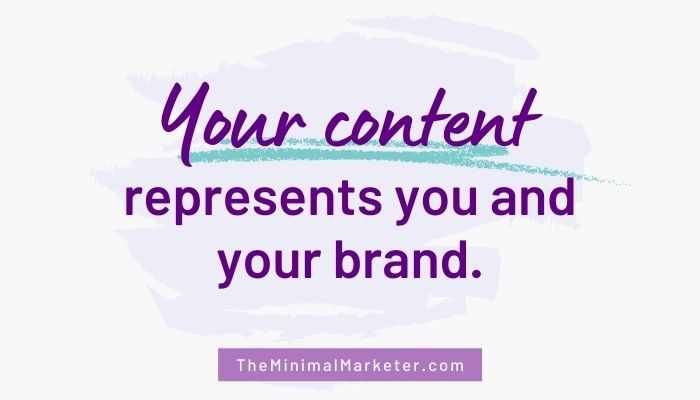
Before someone hires you to solve their problems, they’ll peruse your content for signs that you’re:
- trustworthy and reliable,
- reputable and credible,
- experienced and knowledgeable,
- genuine, authentic, or likeable.
Take a bird’s eye view of what content you’ve sprinkled throughout the atmosphere. What do you see?
Are you providing content that convinces your target market to work with you instead of your competition?
If not, then you need to do something about it. And, that’s what we’re discussing in this post.
After all, content creation is time-consuming, so you want to approach it in a profitable, sustainable way that works to build your business—without derailing your productivity.
That means focusing on the content types that deliver better results by:
- Expressing your personality and human side
- Being relevant to your target market and to your business/offers
- Activating a few persuasion triggers that influence people to say “yes” to you
These six types of content work really well with the persuasion principles of influence, which is major since these factors maximize your chances of converting prospects into buyers. Here’s a quick rundown.
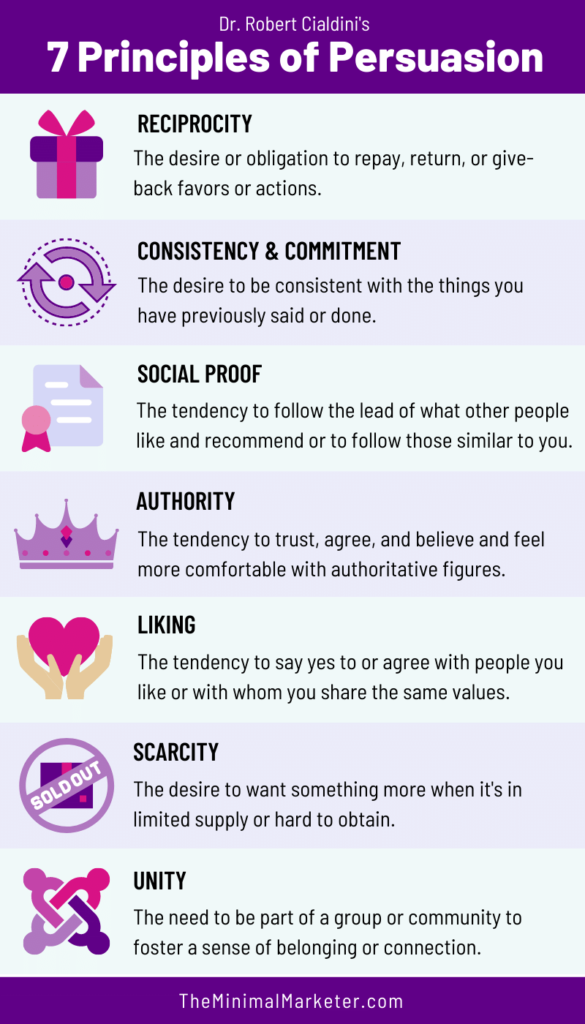
Let’s dive in!
1) Personal Content
Personal content expresses your personality, individuality, style, and sense of humor.
The one thing that differentiates you the most is your personal voice. There may be others who sell what you sell, but there is no other person quite like you.
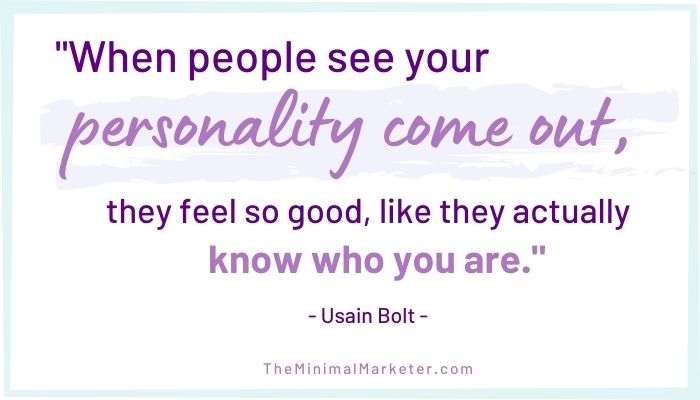
Y.O.U. Marketing (Your Original Uniqueness) attracts the desired/intended people to you. Simultaneously, your personal voice chases away people who aren’t your target audience.
Personal content humanizes your brand so that you can form meaningful connections online. This is important because much is lost without face-to-face interaction.
It’s much easier to form emotional attachments to other people versus logos. Conversations require people.
Admittedly, human connection isn’t a prerequisite to all sales. Do you feel emotional attachment to every product you order from Amazon? Of course not.
But, when you’re selling consulting or coaching or other service-related offers, connection makes a big difference. Maybe even THE difference.
Personal content is one of the content types that fosters the know, like, and trust factor. It shows off your unique personality, values, and beliefs. These days, who you are matters to a lot of consumers.
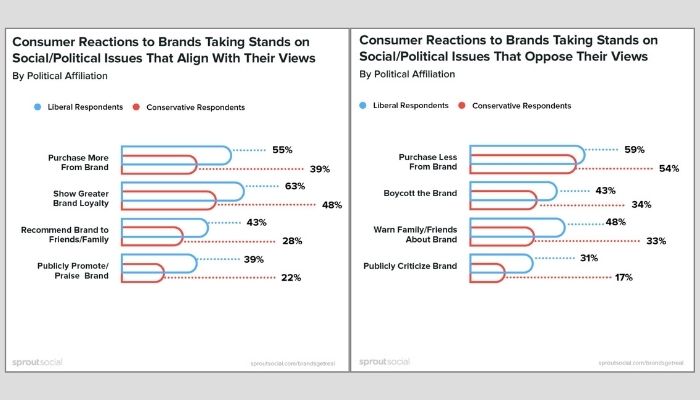
Both influential, successful personal brands as well as lesser known entrepreneurs use this type of content to connect and bond with their target markets. So, consider it!
Pro Tip
To convey your personality, use quotes on social media to communicate your beliefs, point of view, and style.

2) User Generated Content
Some solopreneurs struggle with promoting their products or services. However, selling is a necessary part of running a successful business.
You can avoid the sales pitch through:
- Storytelling
- Emphasizing benefits rather than features
- Highlighting “before and after” descriptions
- Sharing user generated content
Let’s talk more about user generated content (UGC) since it helps your customers do the selling for you. (Yay!)
UGC is the content (text, videos, images, reviews, etc.) that is 1) created by people rather than brands and 2) shared by these brands on social media, websites, and other marketing channels. (Hootsuite)
Often, UGC naturally incorporates storytelling, benefits, and the “before and after” states. This makes it ideal for selling since it answers questions and reduces doubts that your prospects have.
“The customers are the marketers. The content they’re creating is doing our marketing job … much better than us. As soon as you accept that fact, you’ll also come to terms with this idea that our content is not king … their content is king.” – Mark Schaefer, Marketing Strategist
Plus, what other people say about you and your business is more powerful than what you say. In fact, UGC is highly persuasive when it comes to sales.

Check out these stats:
- 79% of customers say UGC has a strong influence on their purchase decisions.
- 92% of consumers experience analysis paralysis when there are no customer testimonials or reviews to justify their purchase.
- 1 in 4 individuals made a purchase after seeing a product in a user’s Instagram story.
- Website product pages containing UGC have been linked to a 29% increase in conversions of online purchases.
- Click-through rates increase by about 73% and produce more conversions when UGC is in email.
So, if you want a way to sell more, UGC is one of the content types to consider.
3) Educational of Informational Content
According to Pew Research, 91% of online adults use search engines to find information on the web. People search the internet everyday to find content that answers questions and helps them find solutions to their struggles.
When you create educational or informational content, you serve the folks who are searching for what you’re talking about. In this role, you appear as a helpful resource and an authority figure. Do this repeatedly and you’ll earn the trust of your audience.
“At the end of the day, our content needs to help us sell more, lower expenses, or create happier customers. Our customers know this, and our content marketing strategies are built around achieving these goals. But the more we educate them or entertain them, the more they don’t mind being sold to.” – Joe Pulizzi, Content Marketing Institute
Although educational and informational content are a bit different, they both:
- foster relationships;
- solve pain points; and,
- activate persuasion triggers of reciprocity, authority, and liking.
In turn, you’ll strengthen your position of influence and build your brand.
Another perk of this content type is that it performs well in search engines. As I mentioned, people are searching online for information and guidance. So, if you create content that aligns with those inquiries, you can boost your SEO too.

Content that educates or informs is a potent tool in your lead generation arsenal. It is excellent top of the funnel content to introduce people to your brand and offers.
Free informational webinars, eBooks, videos, presentations, or email courses are perfect for generating email leads. The more value you offer, the more valuable you’re perceived.
And, of course, you can also offer paid educational or informational content, like workshops or online courses.
4) Visual Content
Hopefully you haven’t been overlooking the use of visuals in your marketing. Research proves that visual content improves conversion.
Your audience is inundated with content, which makes it harder to consume. Visuals are easy, quick, and fun to devour. Your audience prefers them, so it’s what you need to create.
Visuals are superior when it comes to memory, understanding, attention, and engagement. What’s not to love about that?
At the moment, the most impactful and influential type of visual content is video and live streaming. Video allows you to interact in a more conversational way that makes people feel as if they’re with you in person.
Seeing your face and mannerisms as well as hearing your voice establishes feelings of trust, reciprocity, authority, and appreciation much faster. The stats from Wyzowl are impressive:
- 78% of video marketers say video has directly helped increase sales.
- 84% of video marketers say video has helped them generate leads.
- 87% of video marketers say video, in general, gives them a good return on their investment.
- 84% of people say that they’ve been convinced to buy a product or service by watching a brand’s video.
- People watch an average of 18 hours of online video per week.
Of course, video isn’t the only visual content type that’s effective. Infographics, charts, tables, graphs, and graphics are preferable to text. They convey information better than text and get more engagement, which makes them more beneficial than text alone.
Need help identifying your content goals? Download the Content Strategy from Scratch workbook today.
5) Authoritative Content
I mentioned how educational and informational content increases the perception of authority. However, authoritative content goes beyond educating and informing.
When you publish authoritative content, you’re making a unique assertion, expressing a different viewpoint, or revealing new research.
You go from being a resource to being THE source.
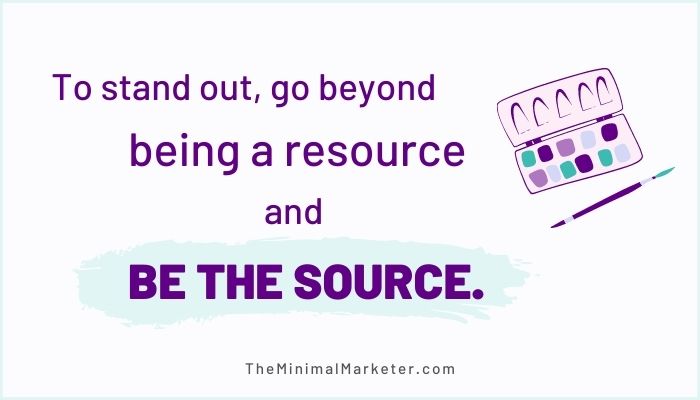
Authoritative content benefits your business in multiple ways. It:
- conveys a strong voice and brand;
- illustrates your expertise;
- increases your visibility;
- attracts more backlinks to your website;
- instills more confidence in your audience; and,
- positions you as a leader in your industry.
Playing it safe by agreeing with everyone in your industry prevents you from getting noticed. If you have your own opinions and results, don’t be stingy with your gold nuggets!
Embrace your knowledge and experience so that you feel comfortable sharing what you know with your audience.
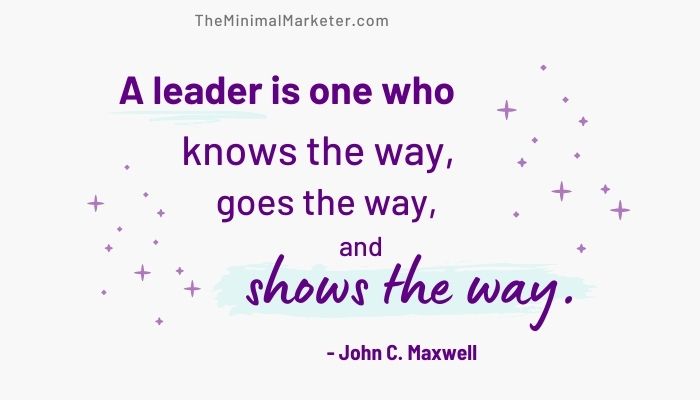
Don’t overlook the significance of an authoritative tone. Make declarations and support them with facts and your reasoning. Act like the leader you want others to see you as.
For example, I tried using a more authoritative tone in a blog post. Writing from a stronger position of expertise and authority made a clear difference. Most notably, that post generated five hot leads, one of whom hired me right away!
Confidence and authority are influential factors when it comes to how others perceive you.
6) Supportive Content
To get ahead faster, you’ll need support. Going at it alone isn’t impossible. But you’re a good person and want to help others to succeed. And many will want to help you in return if you have a mindset of generosity and gratitude.
Supportive content aids the endeavors of your colleagues, friends, and industry influencers while also benefitting your audience. I call this “sharing the love.”

Here are examples of how you can support other people:
- Distribute and re-share their content
- Mention them in social media and your website
- Promote their offers
- Refer to them as experts
- Highlight their savvy and proficiency
There are numerous methods to assist your colleagues, such as social media, blog posts, emails, videos, and testimonials. These efforts expose your audience to your colleagues, which extends their reach and highlights their expertise.
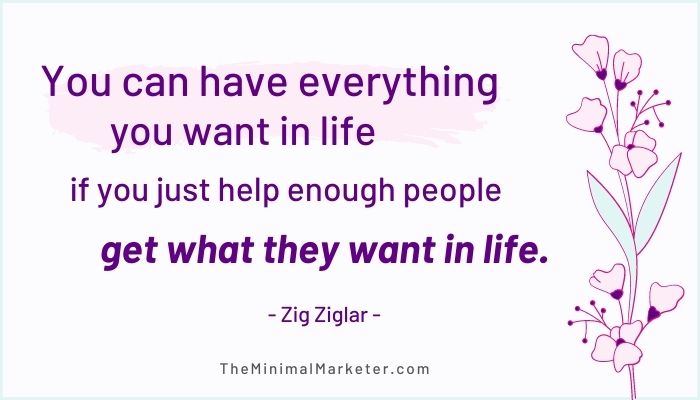
Many times, your bolstering of others helps you, directly or indirectly. This is one way to form relationships online through good will and visibility.
Also, associating yourself with people of influence makes you appear more authoritative and increases your social proof. But, by far the biggest payoff comes when one of your colleagues returns the favor and supports you.
I’m not talking about using people to climb your way to the top! Approach this one with an attitude of “it’s better to give than to receive.”
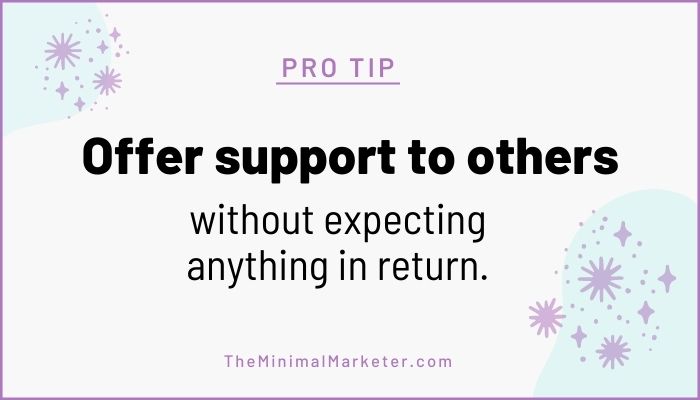
Only support those who you recommend, admire, respect, and are familiar with. Your audience trusts you, and you don’t want to be a sellout. Be genuine when you’re supporting others.
Never expect or demand a response or reciprocation. Remember that you’re not supporting others to get something in return. This is about value and forming connections with your colleagues and your audience.
Before You Take Action on These Content Types, Read This
Some of the most productive, prosperous entrepreneurs and small business owners aren’t online “everywhere.” They’ve strategically chosen the platforms best suited for their personalities and their audience’s preferences. And, through trial and error, they know what content works.
Entrepreneurs like Liz Benny, Bushra Azhar, and David Siteman Garland don’t try to dominate all types of content across every marketing channel in existence. They seem to understand minimal marketing since they have streamlined their tactics to what works versus doing everything.
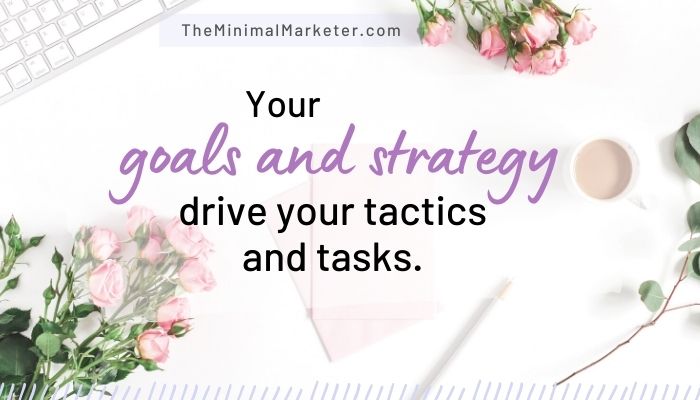
You don’t have to be present on every single social media platform. You don’t have to blog for your business either. It depends. Your goals and strategy drive your tactics and tasks.
So, don’t try to tackle it all and all at once.
Need help identifying your content goals? Download the Content Strategy from Scratch workbook today.
The secret? Create content types that people can’t resist, like the ones we just reviewed. Content that appeals to the heart as well as the head. And, content that is relevant to your audience and to your business goals.
When it comes to your content, answer the questions, activate the buying triggers, and resonate with people. Your content’s impact relies on getting seen and moving your prospects to take action.
After all, you want your content to show people all the many reasons that you are the right choice. Focus on these content types to make a difference in their lives and your own!
UPDATED OCTOBER 19, 2021 | PUBLISHED NOVEMBER 26, 2017

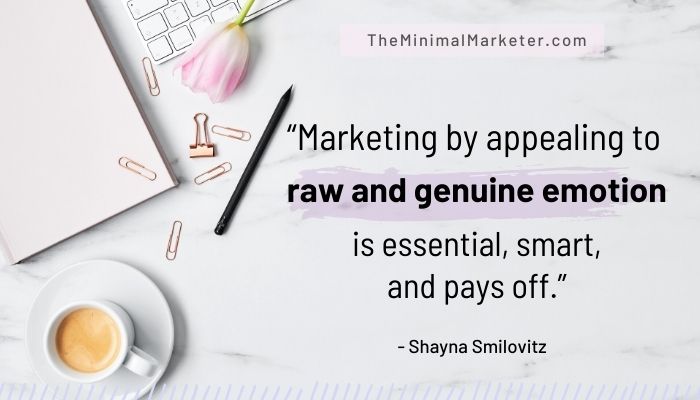
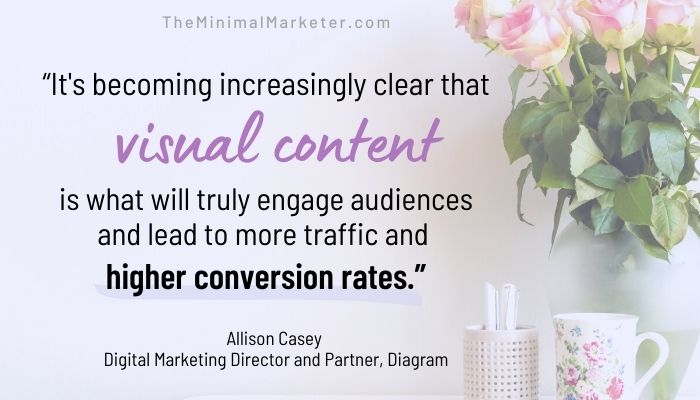
Love the point on “personal content.” Somehow, it sounds like reality tv. Anyway, those people are great examples. They were able to market themselves using themselves as the focal point. Now I am reminded of politicians and even religious leaders that can be categorized using their personal input, too.
Great insight about politicians and religious leaders using personal content! The list goes on. We can add celebrities to it as well. Personal branding is what makes many brands successful. Thanks for the feedback, Lorii!
Fantastic information Meghan. I especially like “The truth is that where you publish isn’t nearly as critical as WHAT you publish.” Staying connected to my clients and customers is important along with giving them valuable information.
What a great content article Meghan. I wish I had had this when I started out. For the most part, I fall into the educational content category. This year I’ve tried to introduce more personal aspects. Also, you mentioned Internet 3 people I’ve not run across, so I will be checking them out, and rethinking the idea of needing to be everywhere on social media. Thanks so much for the heads up on better content.
Terrific Joyce! I think many of us fall into the educational content category. It’s the easiest to create in many ways. Definitely check out those three brands/people. They all are crushing it when it comes to connecting with their ideal audience through minimal but highly targeted content. I will take a few screen caps of their social media to add to the article as well. Appreciate your feedback and compliment!
I always learn a lot when reading your blog posts, Meghan. For me, the video is where I am weakest. I have created several videos over the last year, but then tend to forget to post them again. Every time I do a video with details on my processes, I get lots of comments and likes. incorporating more posts to ask for the sale is where I want to expand my reach.
That’s great to hear, Alene! Video is where many are weakest (me included). It takes a while to ramp up content, whether it be blog content or video content. Then we need to organize that content for distribution using a process. I watched videos turn into sales for quite a few entrepreneurs. It’s kind of crazy! Asking for the sale takes finesse and the right approach so that your audience isn’t turned off. But it’s necessary! Appreciate the comments, thank you. 🙂
Thanks, Meghan, for the straight talk and great content. Your advice is spot on and I will incorporate it into my social media marketing. Thank you!